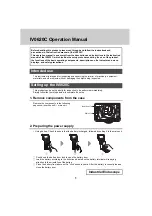
CS615 WATER CONTENT REFLECTOMETER
4
some applications, installation can be improved
by using insertion guides or a pilot tool.
Campbell Scientific offers the CS615G and
CS615P insertion tools. The CS615G is a
probe insertion guide which holds the rods
parallel during rod insertion. The CS615P pilot
tool is essentially the CS615 rods which are
inserted into the soil then removed. This makes
proper installation of the CS615 easier in soils
which are difficult to insert probes into.
6. WIRING
color
function
CR10(X)
21X/CR7
red
+12 V
+12 V
+12 V
green
output
SE analog
channel
pulse
channel
orange
enable
control port
control port
black
ground
G
clear
shield
(ground)
G
NOTE: CS615s manufactured before
12/95 have the green and black leads
reversed. Consult the wiring label near the
end of the cable.
The enable line is set high to put the probe in
the measuring mode.
7. DATALOGGER INSTRUCTIONS
7.1 INTRODUCTION
The output of the CS615 is essentially a square
wave with amplitude
±
2.5 volts and a frequency
which is dependent on the dielectric constant of
the material surrounding the probe rods. The
frequency range is approximately 600 to 1500
Hz. The period (0.7 to 1.6 milliseconds) is used
in the calibration for water content.
The Pulse Count instruction of a CR10, CR500,
21X or CR7 dataloggers can be used with the
CS615 output connected to a pulse count
channel. The Period Measurement instruction
of the CR10 or CR500 can be used with the
CS615 output connected to a single-ended
analog channel.
7.2 PULSE COUNT
It is important to understand the event
sequence during the Instruction 3 Pulse Count
Measurement when using it with the CS615.
See the Instructions section of the datalogger
manual for a detailed explanation of the Pulse
Count instruction.
A brief explanation of pulse count use in a
CS615 application is presented here. The LOW
LEVEL AC option for the configuration code is
used, and the output is selected for frequency
(Hz). Period (msec) is easily obtained with the
Inverse instruction (42).
TABLE 1. Instruction 3 Pulse Count
Measurement Sample Program
;{21X}
;Simple program to demonstrate use of
;pulse count instruction with CS615
;
*Table 1 Program
01:
2.0
Execution Interval (seconds)
1: If time is (P92)
1:
0000
Minutes into a
2:
15
Minute Interval
3:
30
Then Do
2: Do (P86) ;set CS615 enable high
1:
41
Set Port 1 High
3: Beginning of Loop (P87)
1:
1
Delay
2:
2
Loop Count
4: End (P95)
5: Pulse (P3)
1:
1
Reps
2:
1
Pulse Input Channel
3:
21
Low Level AC, Output Hz
4:
1
Loc [ kHz ]
5:
.001
Mult ;convert Hz to kHz
6:
0.0
Offset
6: Do (P86) ;set CS615 enable low
1:
51
Set Port 1 Low
7: End (P95)
End Program
































